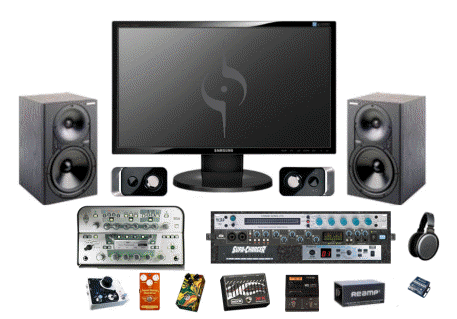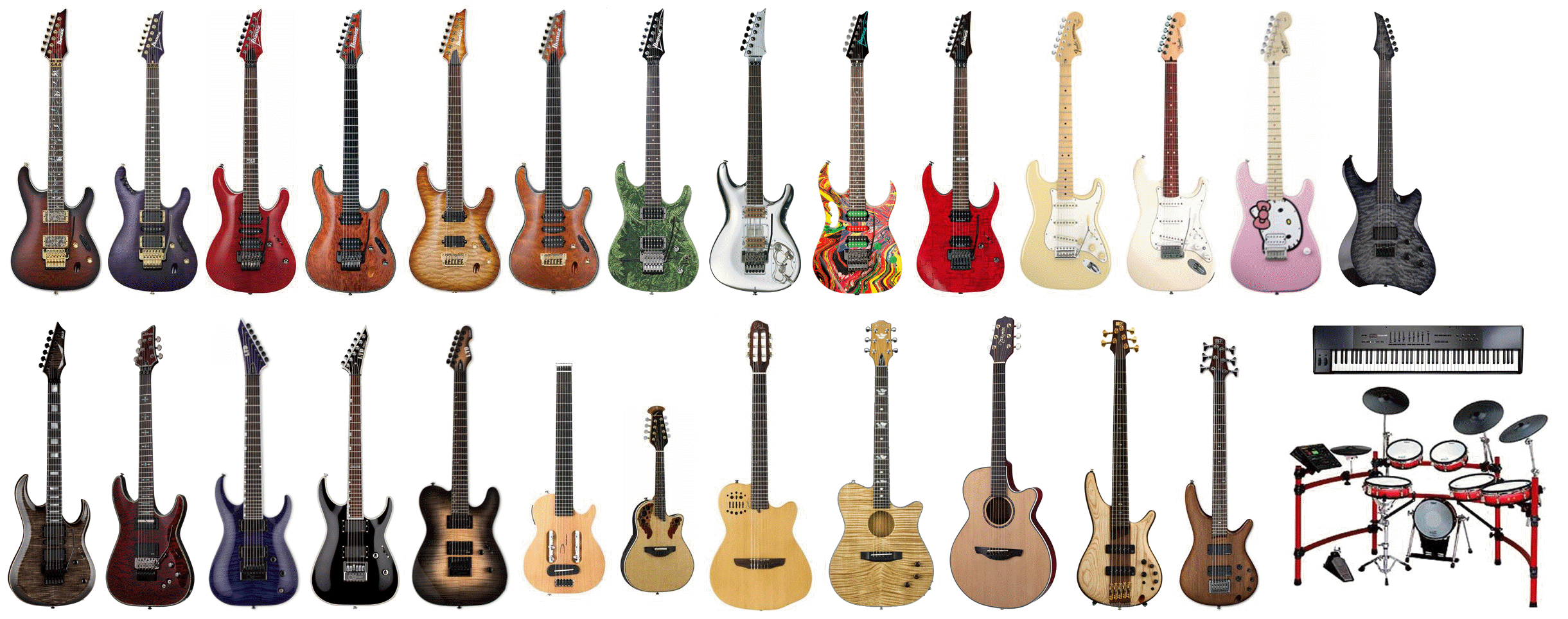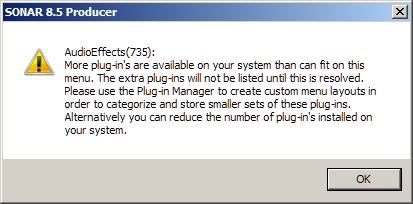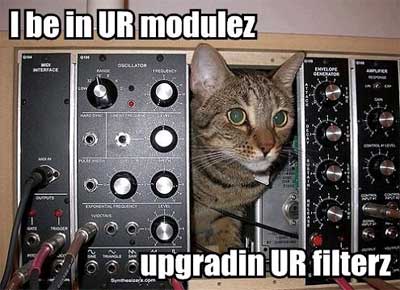
`
Last modification: 01/19/08 19:26
Basic Recording Setup (click to enlarge. For semi-current pedalboard, click here)
My project studio has evolved over the years in four phases, pretty much mirroring the state of technology at the time.
Notice a pattern? The only consistent piece of gear has been Cakewalk - and it's not even a piece of gear! Although some items from the Mk. II era still come in handy (ADATs make great A/D converters for example) most everything has been reduced to a few boxes that sit on my desk. Most. For the past few years I've been quietly adding analog gear to the mix, to the point where my current guitar signal chain is about 2/3 digital and 1/3 analog. Having exhausted just about all that one can do with software modelers, I've come to the conclusion that while they do beat most gear hands down, there's still room for improvement in the super-critical areas of saturation and speaker modeling.
Of course, all the gear is irrelevant if you don't have songs to record - and this is where serendipity comes in. Not being a formula writer, (and sometimes I wish I was!), all I can do is catalog my musical ideas when they arise. This could be while noodling, taking a shower, driving in the car, or waking up for a good night's sleep. Two sections might be song, three could be, and five definitely is. That's my rule of thumb - it takes at least Five Interesting Parts to make a decent song. By the time something feels ready to flesh out, I'll fire up SONAR and start comping guitar parts to a click track. This is often followed by a MIDI arrangement, but as DAW programs evolve (hallelujah!) even audio editing has become flexible and MIDI-like. Still, I usually sequence things fully in order to help debug the arrangement in addition to providing guides for layering and transcription purposes. Tone-wise, the amp tones I create at recording time are for monitoring purposes only; the actual guitars are recorded clean (that's what the direct box is for) so I can REAMP them later and save my amp decisions for the final mix.
The great thing about working with a DAW such as SONAR is that you have the luxury of working on small sections at a time. Envisioning an entire instrumental at once is just grueling - but coming up with 8 more interesting bars? Now that I can do. Copy 'n paste, connect the sections, layer things up, think like a drummer!
Speaking of drums, drum parts are best done last when doing things by yourself for several reasons. First, it means that you can't slack off on the groove while writing your melodies, chords and riffs; they have to be rhythmically interesting all by themselves. And secondly, by programming the drums last your song is in a fully arranged state. Hence, you know already where all the accents should be so you're in a position to Orchestrate the drums to the song rather than the other way 'round. Given that poorly programmed drums are often the biggest giveaway that your track is a Demo, why settle for less? It's too easy to get into that "Just A Demo" mindset - aim as high as you can at every possible moment when recording. If it still sounds like a demo when you're done, well at least it wasn't for lack of trying... ;)

Instrument Gallery (click to enlarge)
I'm going to wrap this up with a few things that I've found useful. Some of them may not be the newest, but they're all good enough to be considered "meat and potatoes"...
NOTE: Software deemed "abandonware" on this page is software that is no longer being manufactured or sold by anyone, in any form. To top things off, if the company that manufactured it is still around, the software itself has been expressly discontinued. Still got a problem? Email me and I'll take care of it. (Also see: "US Copyright Office Grants Abandonware Rights", article here.)
Amp Modeling
Line6 GearBox Plugin:
http://line6.com/gearbox_plugin/
Line6 TonePort: http://line6.com/toneport
Applications
SONAR:
https://www.bandlab.com/products/cakewalk
MAGIX Sound Forge:
https://www.magix.com/us/music/sound-forge/
Audio Plugins
Antares Harmony Engine: www.antarestech.com
BBE Sonic Maximizer: www.cakewalk.com
Cakewalk AudioFX 1-3 (DirectX Compressor, Amp/Tape sim, Ray-tracing reverb
designer) Download
![]()
iZotope Ozone: www.izotope.com
Waves Native Plugins: www.waves.com
Image Line Maximus:
http://www.image-line.com

Software Synthesizers
PowerFX Dyad: Possibly the nicest of the stand-alone SoundFont softsynths:
www.powerfx.com
rgc:audio sfz+, like above but for power users - trés scriptable! www.cakewalk.com
Edirol HyperCanvas HQ (abandonware):
Download
![]()
Edirol Orchestral HQ Softsynth: (abandonware):
Download
![]()
LiveSynth Pro, Sound Font-compatible DXi plugin (abandonware, but great for
single-core PC's): Download
![]()
Sound Libraries
Sonic Implants (various sets): www.sonicimplants.com
Spectrasonics Trilogy (bass):
http://www.spectrasonics.net/instruments/trilogy.html
Native Instruments Bandstand and Battery:
http://www.native-instruments.com/
Tools
Adobe Audition 3 (for its spectral editing and excellent MP3 Pro encoder) -
www.adobe.com
Alive SoundFont Editor: www.SoundFaction.com
AWave Studio (soundfont conversion) www.fmjsoft.com
Izotope RX - www.izotope.com (noise
reduction & spectral editing)
MusicMatch Jukebox Free (mainly for its great 24-bit MP3Pro encoder, abandonware):
Download
![]()
Peter Urbanik's W32dasm (final version 8.94 from 1999, full):
Download
![]()

Mix Bookshelf (The "Best Of" Dallas' recording library. Apologies if some of these are out of print - track 'em down!)
The
Billboard Book of Rhythm - Steve Savage
The
Billboard Book of Rock Arranging - Mark Michaels, Jackson Braider
The BOSS Book -Hal Leonard Corp.
Cakewalk Synthesizers - From Presets to Power User - Simon Cann
The Daily Adventures Of Mixerman - Mixerman
![]() Digital Audio Explained: For The Audio Engineer - Nika Aldrich
Digital Audio Explained: For The Audio Engineer - Nika Aldrich
Guerilla Home Recording - Karl Coryat
Guitar Effects Pedals: the practical handbook - Dave Hunter
Here, There And Everywhere - Geoff Emerick
How
To Write Songs On Guitar - Rikki Rooksby (all of Rikki's books are great.)
How To Play Piano Despite Years Of Lessons (great info on non-diatonic
progressions) - Ward Cannel & Fred Marx
![]() How Music Works - John Powell (great hard to find info on instruments &
psychoacoustics, gently presented!)
How Music Works - John Powell (great hard to find info on instruments &
psychoacoustics, gently presented!)
Introduction to
Sound Recording (eBook-in-progress) - Geoff Martin
Mastering Audio
- The Art and the Science (2nd ed.) - Bob Katz
![]() Mixing Audio : Concepts, Practices & Tools - Roey Izhaki
Mixing Audio : Concepts, Practices & Tools - Roey Izhaki
The Mixing Engineer's Handbook, 2nd. ed - Bobby Owsinski
![]() Mixing Secrets for the Small Studio - Mike Senior
Mixing Secrets for the Small Studio - Mike Senior
Mixing With Your Mind - Michael
Paul Stavrou
Multi-Platinum Pro Tools: Advanced Editing, Pocketing and Autotuning Techniques
- Adam & Barnett
Plug-In Power: The Comprehensive DSP guide - Ashley Shepherd
Production
Mixing Mastering With Waves - Anthony Egizii
Recording Great Audio Tracks In A Small Studio (w/DVD) - Bill Gibson
![]() Personal Studio
Series: The Complete Recording Guide - Discmakers. Free - with surprisingly
good tips!
Personal Studio
Series: The Complete Recording Guide - Discmakers. Free - with surprisingly
good tips!
Robin Schmidt's Music Engineering
Tutorials (.PDF) - Robin Schmidt
Secrets
To Writing Killer Metal Songs - Troy Stetina, Shauna Joyce (Why is this the
only book of its kind? Terrific, but unfortunately out of print.
Wolf Marshall, where are you?)
Secrets of Negotiating a Record Contract - Moses Avalon
Sonar
3: Mixing & Mastering - Craig Anderton
Sonar 5 Overdrive - James Christensen
Sonar Insider - Craig Anderton
![]() Sound FX - Alexander U. Case
Sound FX - Alexander U. Case
Total
Recording - David Moulton (Besides having 'Golden Ears', Dave also wrote one of the best articles
on EQ there ever was,
Spectral
Management.)
![]() Understanding Records: A Field Guide to Recording Practice - Jay Hodgson.
"Lift" distortion? "Reinforcement" distortion? Lots of very recent book
references - not old stuff!
Understanding Records: A Field Guide to Recording Practice - Jay Hodgson.
"Lift" distortion? "Reinforcement" distortion? Lots of very recent book
references - not old stuff!
Writing
Music for Hit Songs - Jai Josefs
![]() Zen And The Art Of Mixing - Mixerman (Eric Sarafin's "other" book, and for a
mix-outside-the-box guy, it's a good read)
Zen And The Art Of Mixing - Mixerman (Eric Sarafin's "other" book, and for a
mix-outside-the-box guy, it's a good read)
![]() MIDI.ORG PDF Specs Archive
(.zip) - finally you don't have to pay for these anymore! Also see
here.
MIDI.ORG PDF Specs Archive
(.zip) - finally you don't have to pay for these anymore! Also see
here.
Mix It Like A Record (DVD) - Charles
Dye ![]()
Shane Wilsons's
Guide To Mixing (DVD) - Shane Wilson
![]()
Music Engineering Bookshelf (When you want to dig deeper. These are some of the friendliest books I've found for what can be a very arcane subject)
The Computer Music Tutorial - Curtis Roads (and it's still in print!)
DAFX: Digital Audio Effects - Udo Zolzer, editor
![]() Design And Construction of Tube Guitar Amplifiers - Robert Megantz
Design And Construction of Tube Guitar Amplifiers - Robert Megantz
![]() Designing Sound - Andy Farnell
Designing Sound - Andy Farnell
A Digital Signal Processing Primer (with Applications to Digital Audio &
Computer Music) - Ken Steiglitz
Digital Audio Signal Processing (The Computer Music and Digital Audio
Series) - John Strawn, Editor
Digital Signal Processing: A Practical Guide for Engineers and Scientists -
Steven W. Smith
Digital Signal Processing Demystified - James D. Broesch
Digital Signal Processing and the Microcontroller (Motorola University) -
Grover & Deller
DIY
Speaker Cabinets for Musical Instrument Applications (London Power Series) -
Kevin O'Connor
DSP Filters (Electronics Cookbook Series) - Lane, Datta, Karley & Norwood
DSP First: A Multimedia Approach - McClellan, Schafer & Yoder
FM Theory And Applications - By Musicians For Musicians - John Chowning &
David Bristow
![]() Introduction To Digital Filters With Audio Applications - Julius O. Smith
III
Introduction To Digital Filters With Audio Applications - Julius O. Smith
III
![]() Learning Matlab - The
Mathworks, Inc.
Learning Matlab - The
Mathworks, Inc.
Principles Of Digital Audio (6th ed) - Ken Pohlmann
The Scientist and Engineer's Guide to Digital
Signal Processing - Steven W. Smith
![]() The Ultimate Tone Vol. 6 - Kevin O'Connor
The Ultimate Tone Vol. 6 - Kevin O'Connor
![]() Electric Guitar Sound
Secrets and Technology - Helmuth Lemme (Best book on pickup & guitar physics
I've ever read.)
Electric Guitar Sound
Secrets and Technology - Helmuth Lemme (Best book on pickup & guitar physics
I've ever read.)
...and pretty much anything by John Watkinson. And remember:
